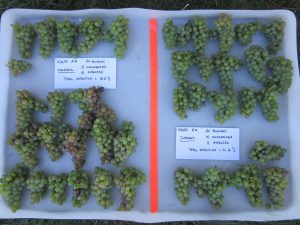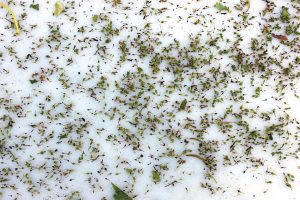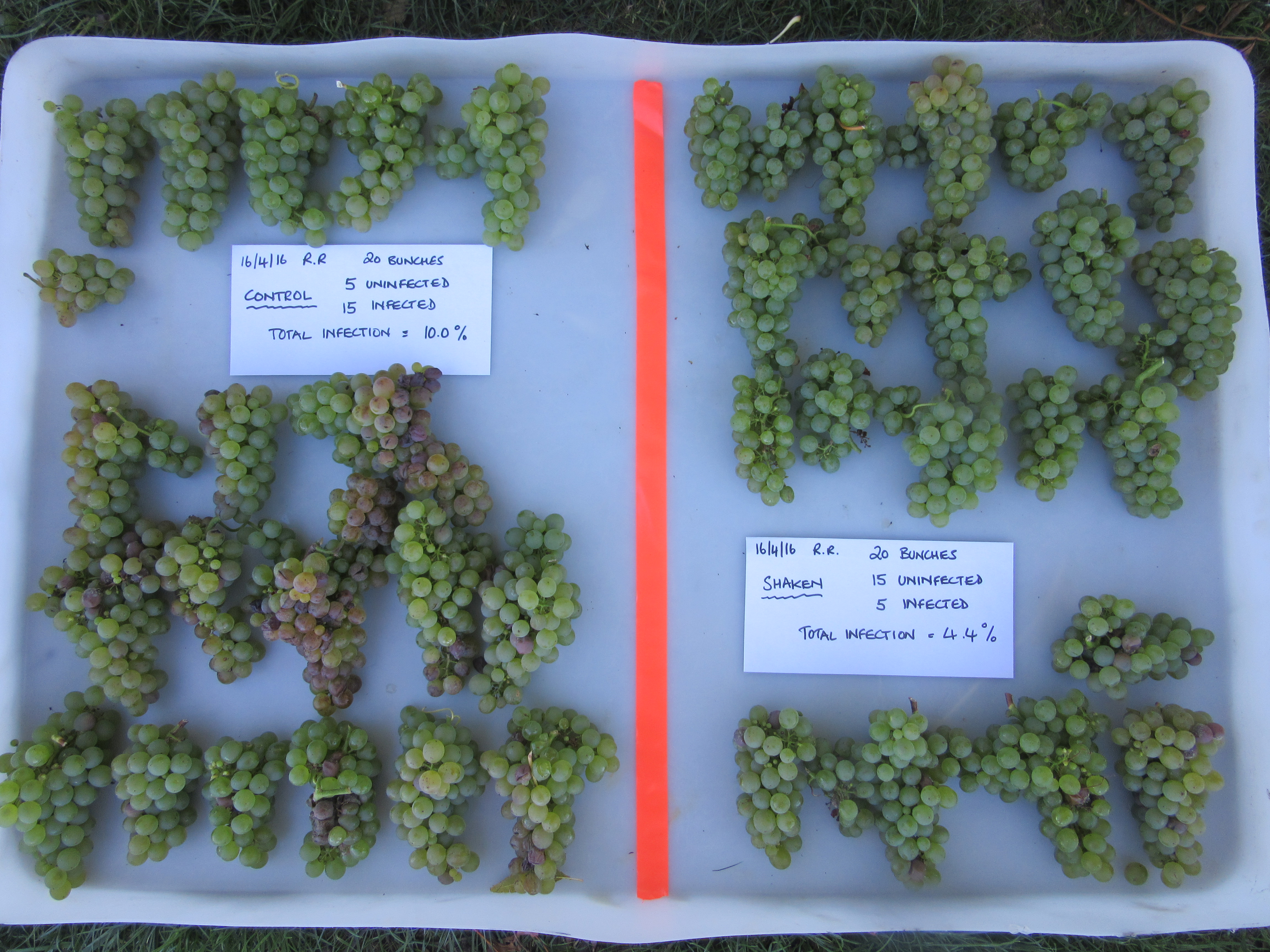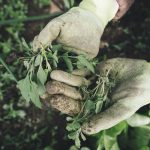What started out as a method of crop control has yielded surprising results in the control of botrytis. Sonya Logan reports.

Bunches of Sauvignon Blanc from unshaken (left) and shaken vines. The vine shaking in this case was regarded as heavy and resulted in a 56% improvement in botrytis infection and 20% reduction in crop.
What if I told you there was a chemical-free method of controlling botrytis that has proven to be up to 80% more effective than fungicide sprays alone and could already be sitting in your vineyard shed right now?
I’m talking about the humble grape harvester. Ten years ago, the New Zealand wine industry looked to Australia for a solution to control its crop levels after observing the effectiveness of mechanical fruit thinning in Aussie vineyards. Now the Kiwis are giving back after extensive trials have repeatedly demonstrated how giving vines a bit of shake with a harvester just before bunch closure, even if you don’t drop crop, can reduce botrytis infection by at least 50%.
And there’s at least one major New Zealand wine company, Villa Maria, which has adopted the technique as an integral part of its viticulture program.
The discovery came as something of a surprise to New Zealand researchers which first emerged during trials of mechanical fruit thinning in commercial vineyards in Marlborough by Plant & Food Research during the 2010 harvest. The trials had been prompted by a very large, significantly botrytis-affected vintage in Marlborough in 2008 which saw the region’s growers take a substantial hit to their returns.
As well as monitoring the effectiveness of various harvester settings to bring about a range of yield reductions on a number of varieties, the researchers also recorded botrytis infection levels. Not only did the trials show mechanical thinning prior to bunch closure was an easy method for controlling yields, but beating the vines, whether lightly to just knock off a few berries, or vigorously to remove a proportion of berries, shoulders and some whole bunches, led to a reduction in botrytis too.
Buoyed by the initial results from this single-year trial, the researchers wanted to investigate mechanical thinning and its effect on botrytis further. Another three-year trial followed which was managed by New Zealand viticultural consultant Mark Allen and involved around 90 sites from around the country and a variety of harvesters.
Beginning in 2012, the trial attracted four major wineries as participating partners: Pernod Ricard, Villa Maria, Constellation and Whither Hills. Right from the first year, the trial yet again showed the effectiveness of mechanical thinning in reducing winegrape crops and controlling botrytis.
“The harder we hit the vines we got slightly better control in botrytis,” Mark Allen recalled.

New Zealand Viticultural Consultant Mark Allen
Vine trash monitored
Acknowledging the role of vine trash as a source of inoculum for botrytis, in this trial it was decided to also measure the amount of decaying floral parts and leaf material that was dislodged by the passing harvesters, with white plastic bin lids placed under vines for this to be easily seen along with the fruit being knocked off.
In the third year of the trial, 2014, the season produced another big crop. Some vineyards cropped as high as 30-40 tonnes per hectare.
“Harvesters were going 24/7 as a crop reduction measure, but we were also still monitoring for botrytis immediately prior to harvest. The effectiveness of fruit thinning in controlling botrytis just kept coming up. We were consistently getting 50% if not 80% better control of botrytis compared with just spraying. In 2014, most of the Sauvignon Blanc controls were sitting on 10-15% botrytis infection. Most wineries have an acceptance of no more than 5%. Anything that was thinned came in at under 5%,” Allen said, adding not a single shaken site had a higher level of botrytis.
“Whether it was a low pressure year or a high pressure year, growers were still enjoying the relevant benefit of shaking for botrytis.
“Botrytis has always been a limiting factor in New Zealand except in Central Otago where botrytis rarely occurs. We’d never seen anything like this.”
An economic analysis of the results from the three-year trial showed that mechanical thinning delivered a worthwhile outcome for botrytis control in eight out of 10 years. Allen said the reason there wasn’t a perfect 10 out of 10 was simply due to the likelihood of a couple of seasons when botrytis wasn’t an issue at all.
With four years of encouraging results now on the board and the three-year trial complete, Allen was keen to delve deeper still into the benefits of vine shaking for botrytis control. This time, he wanted to see if shaking vines lightly without removing crop would still result in a drop in botrytis.
Unfortunately, 2015 proved to be a light-cropping year. Out of all the participants from the previous three-year trial only 5% said they wanted to take part in another trial for fear of losing any of their already lean crops. And of those growers who said ‘yes’, many were only prepared to sacrifice a couple of vine rows for the trial.
Despite the light crops, many of the growers who declined to take part in the 2015 trial would soon wish they had after rain events prior to harvest led to significant botrytis infections for many growers.
For those who did take part, their trial vines were given a light shaking by a harvester travelling at between 5-5.5km/hour and set up with three pairs of rods – one set aimed at the trunk and two about 50mm above the fruit zone.
The answer on the botrytis question was another resounding ‘yes’.
“Even in light cropping years the role of shaking vines in controlling botrytis was shown to be just as important if not more,” Allen said.

White trays from under a harvester being used to shale vines to control botrytis show the amount of trash dislodged from the canopy.
This article was originally printed in the September 2018 issue of Grapegrower & Winemaker magazine.
For articles like this and more, subscribe to the Grapegrower & Winemaker now!














